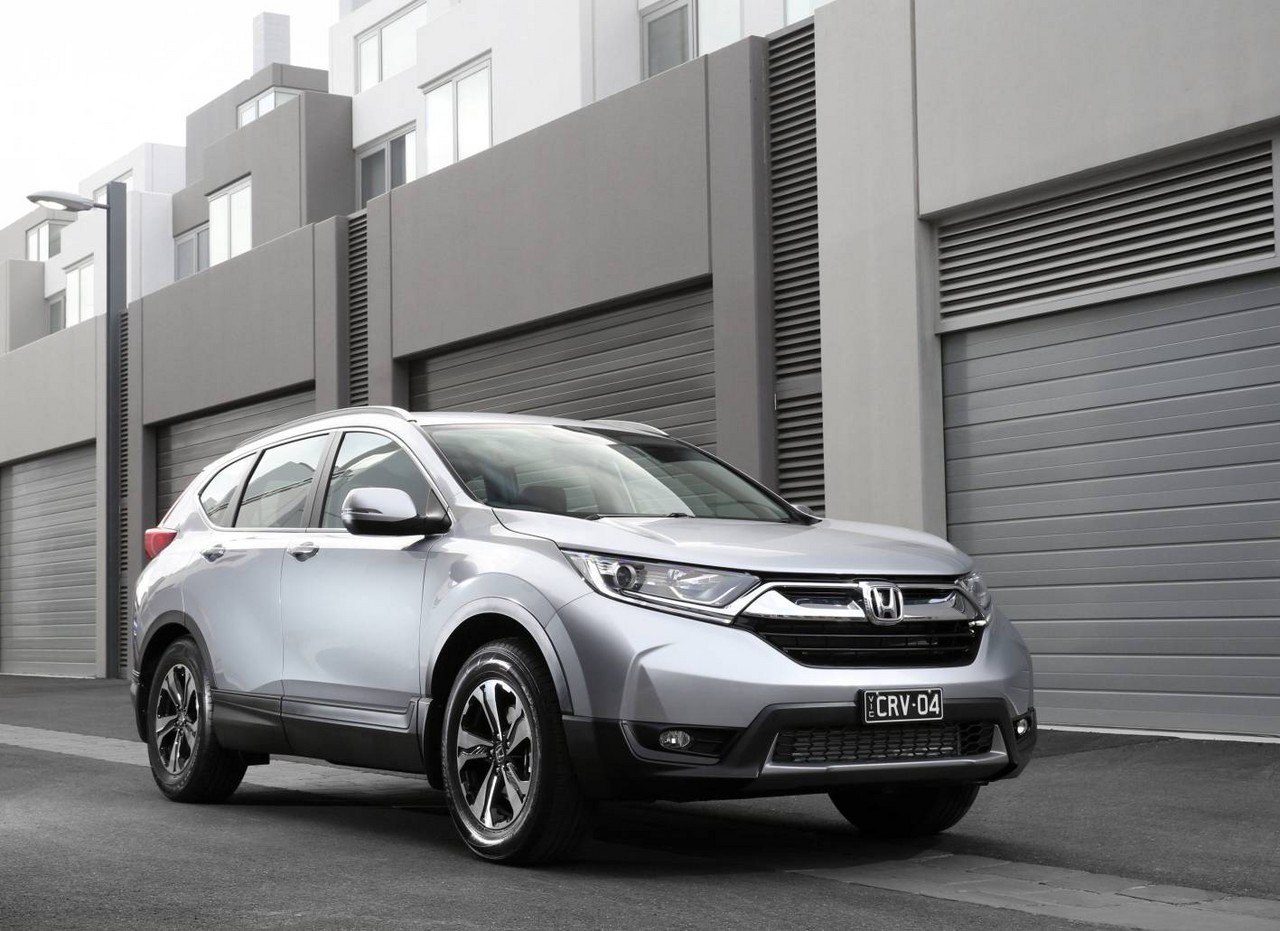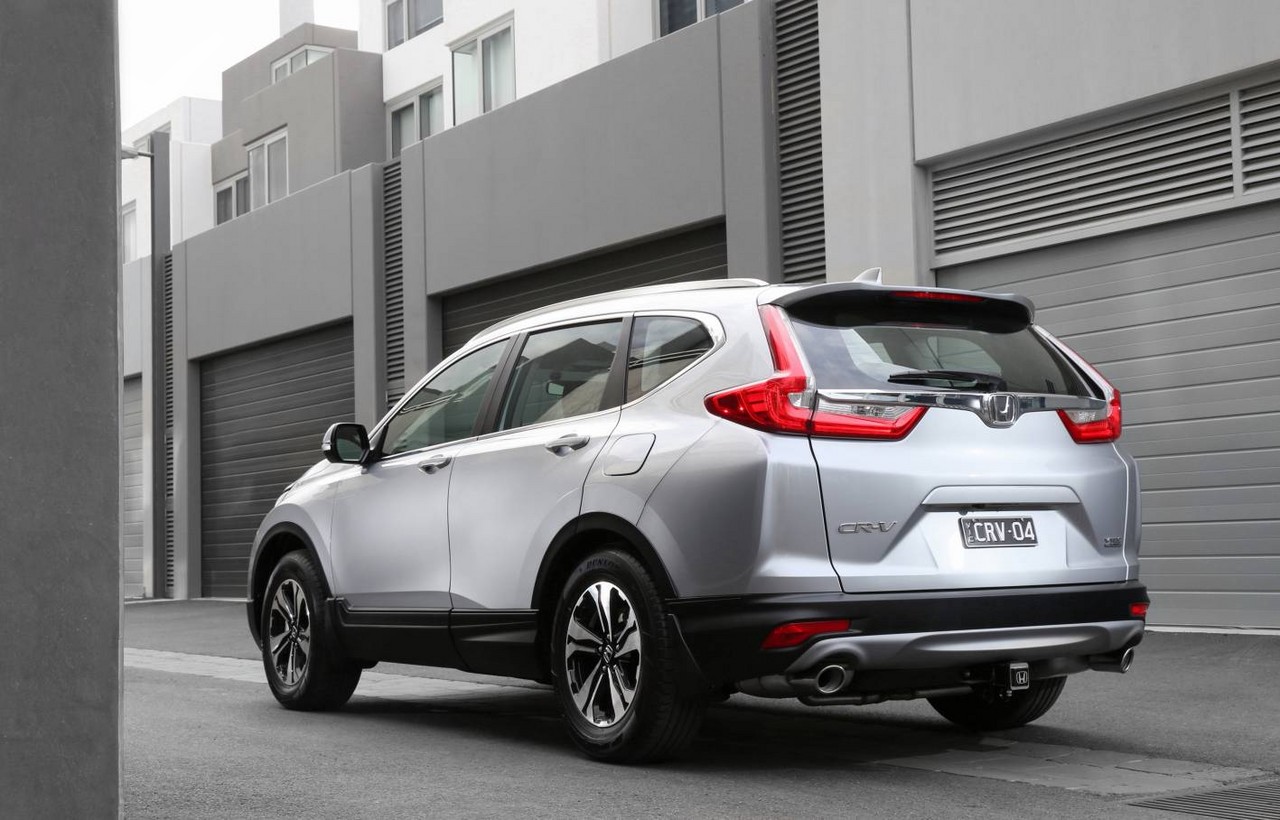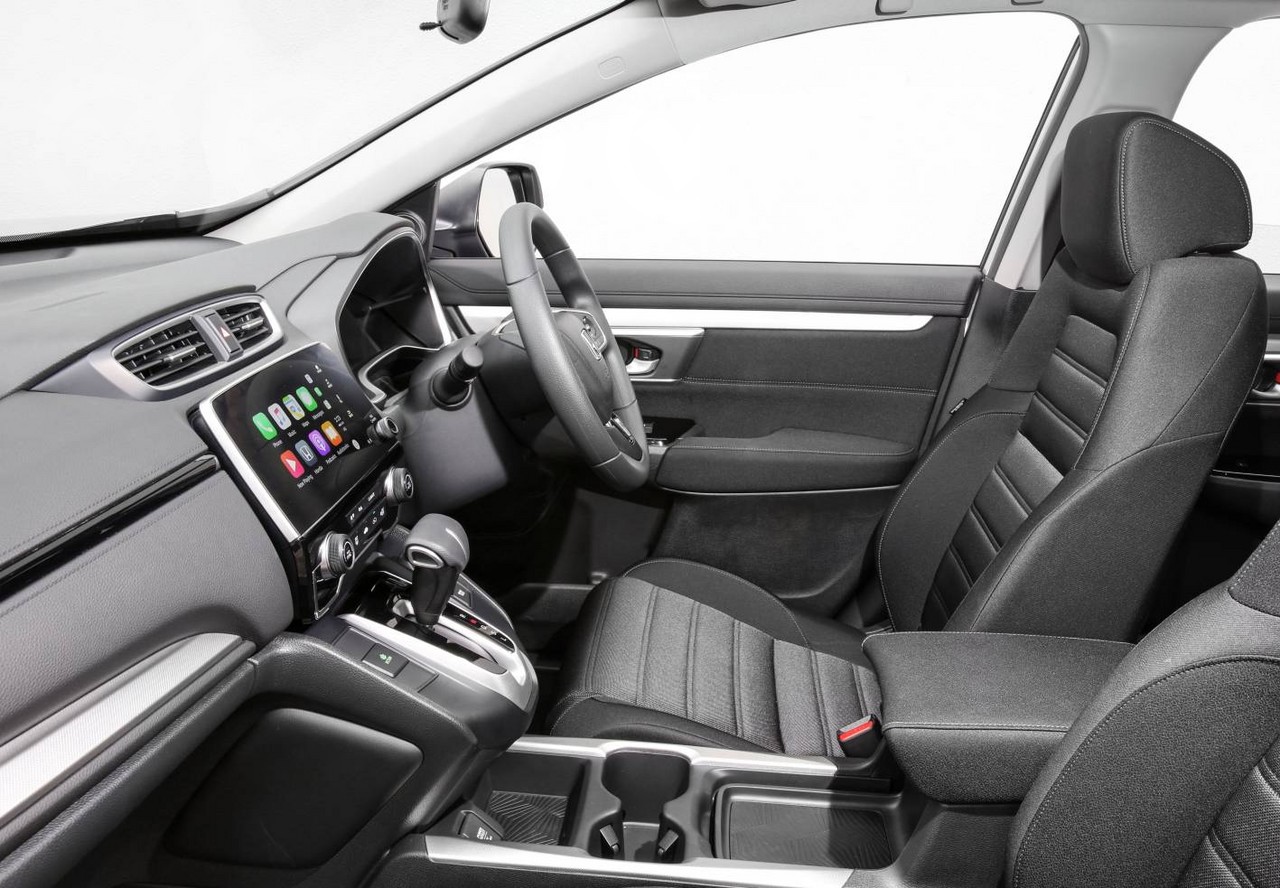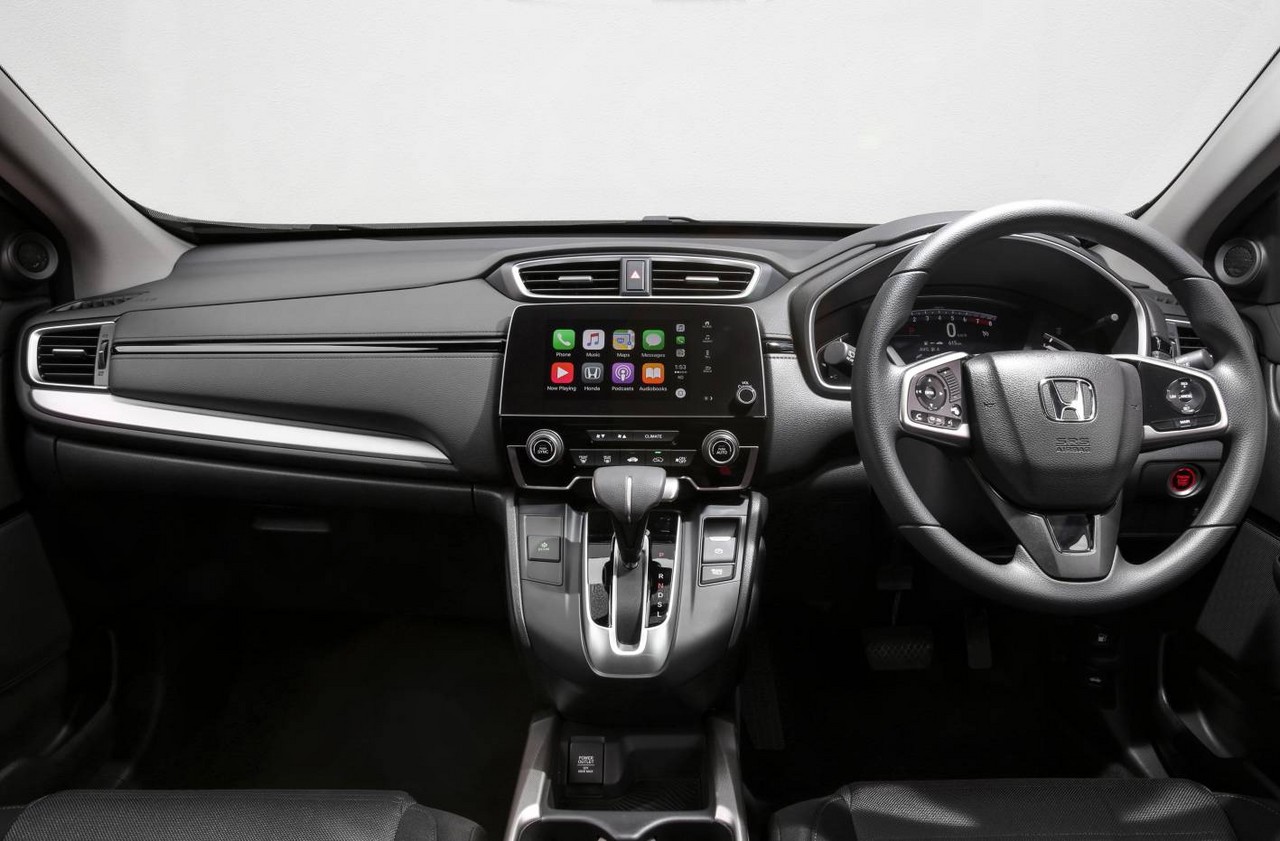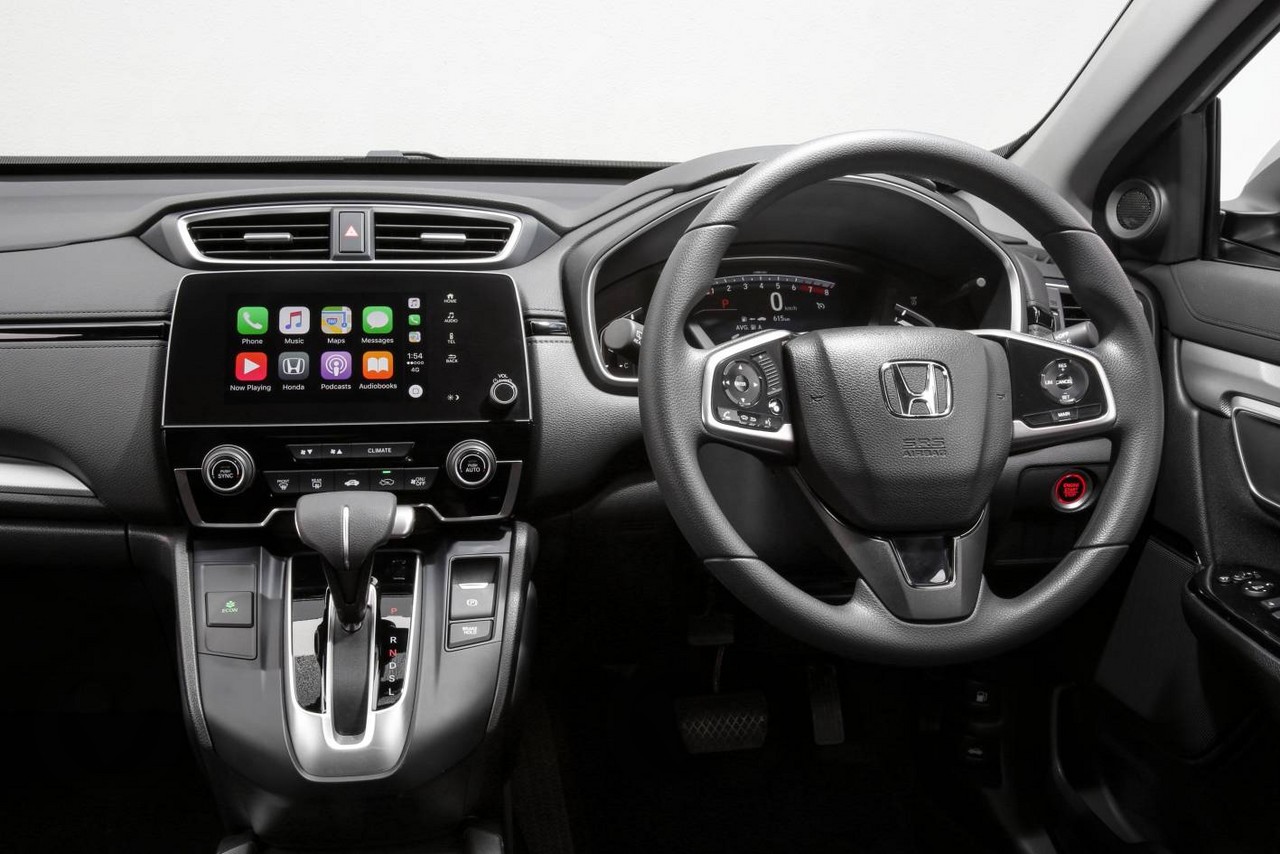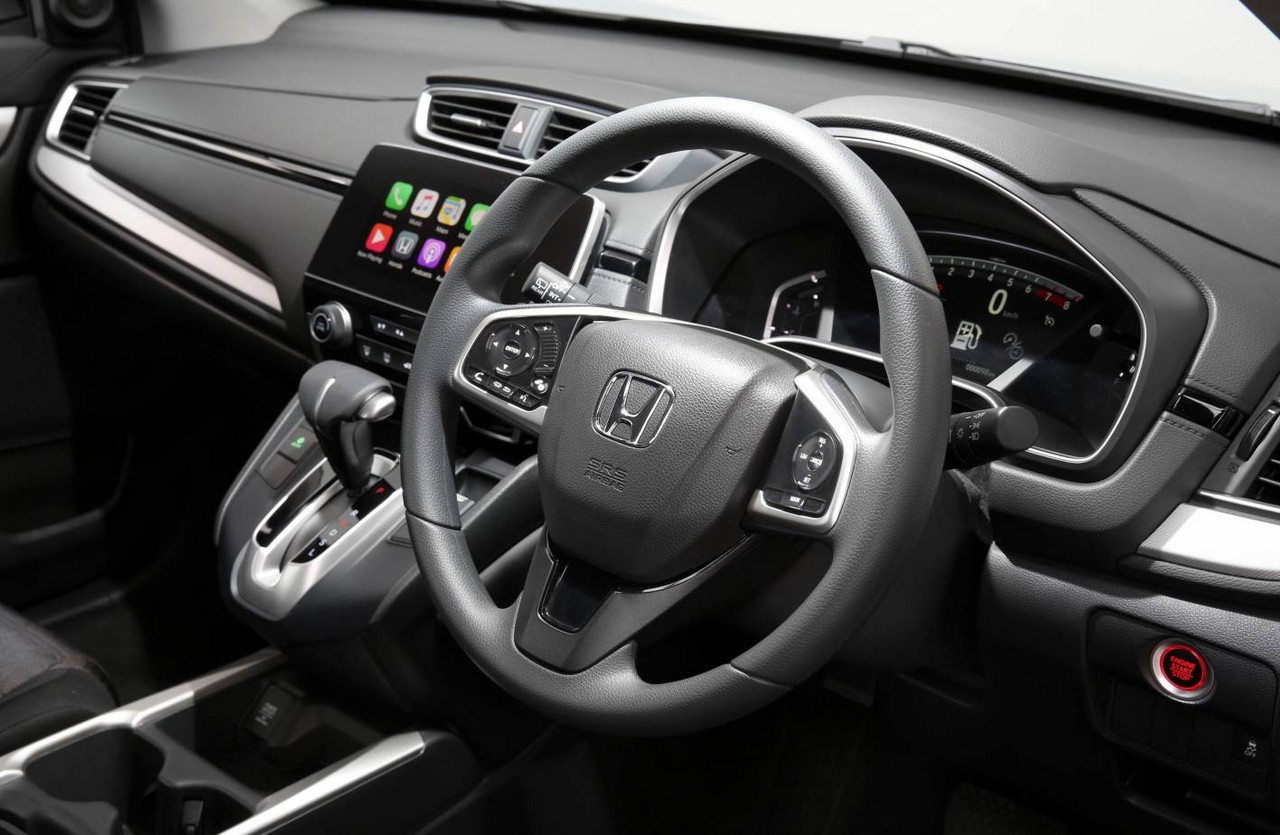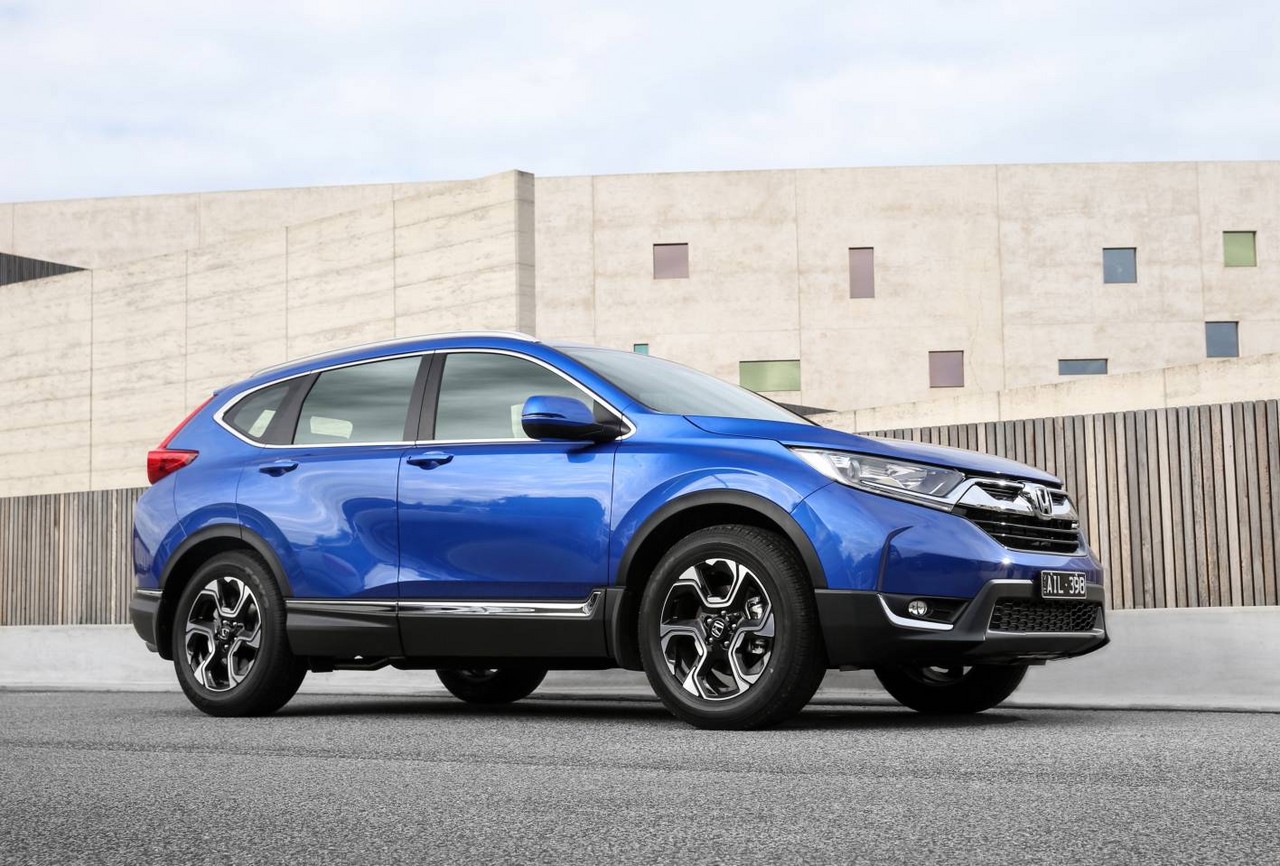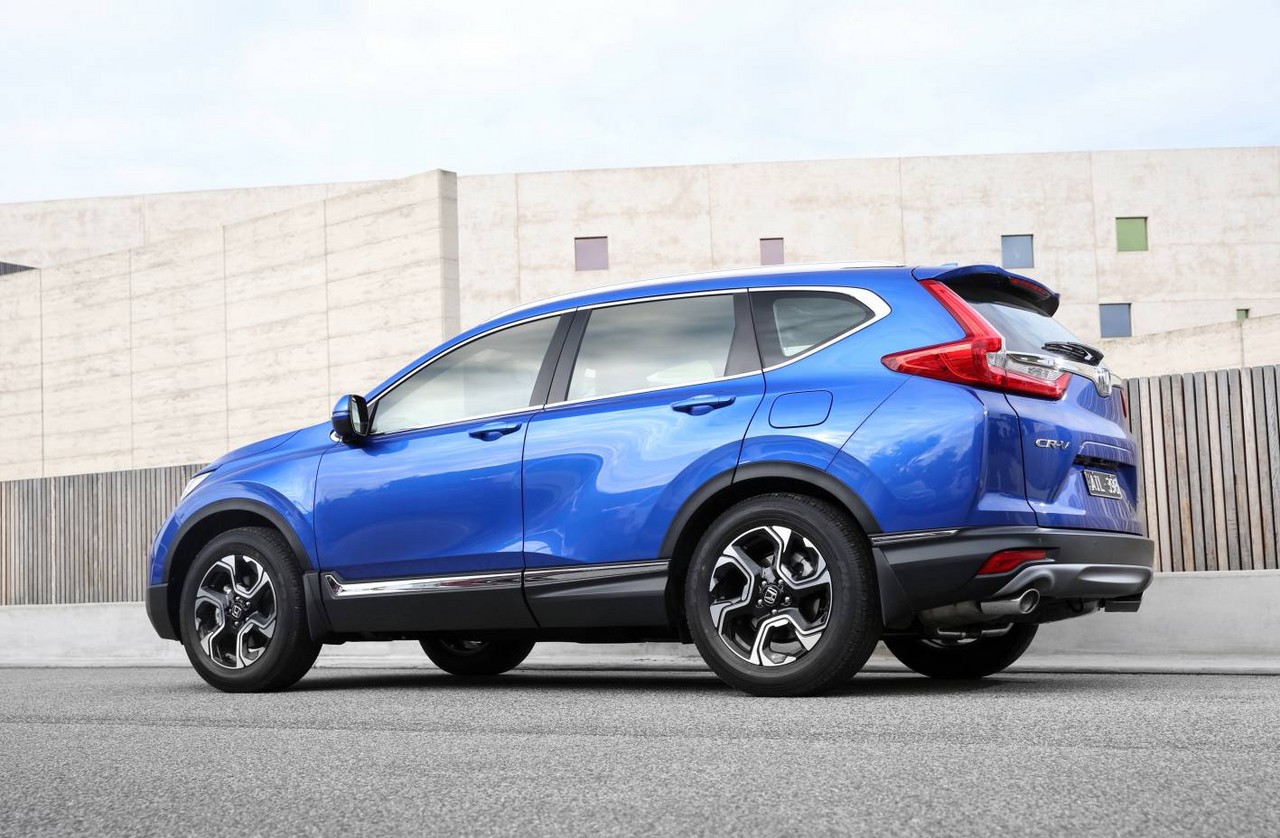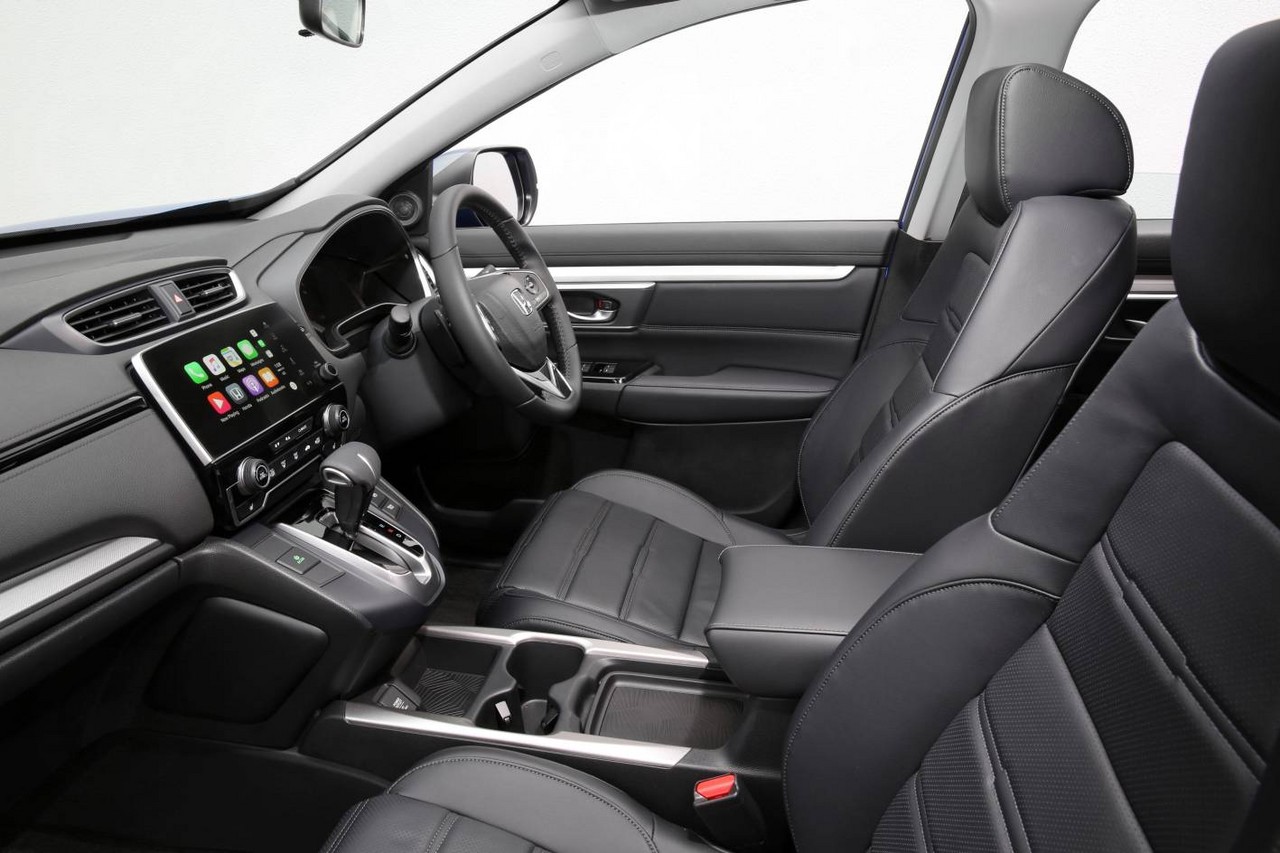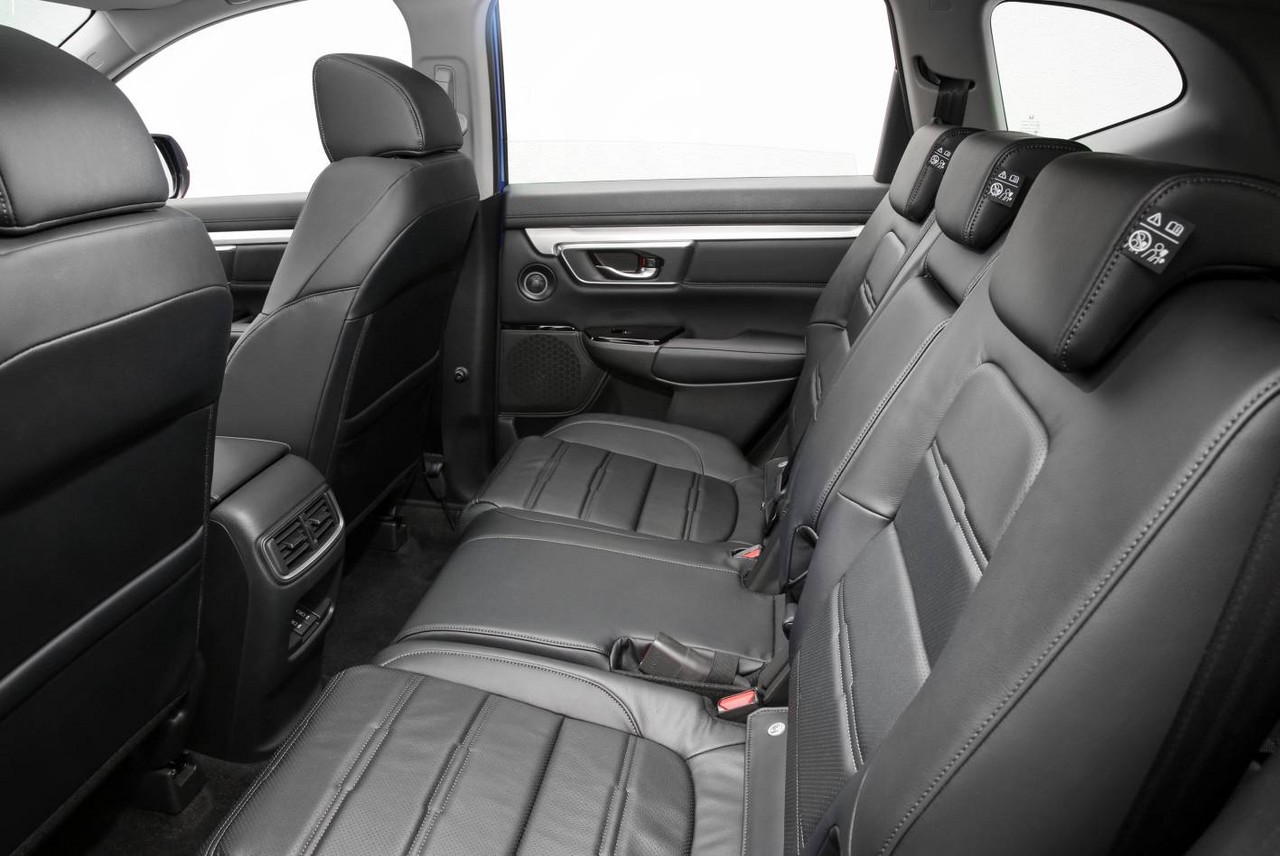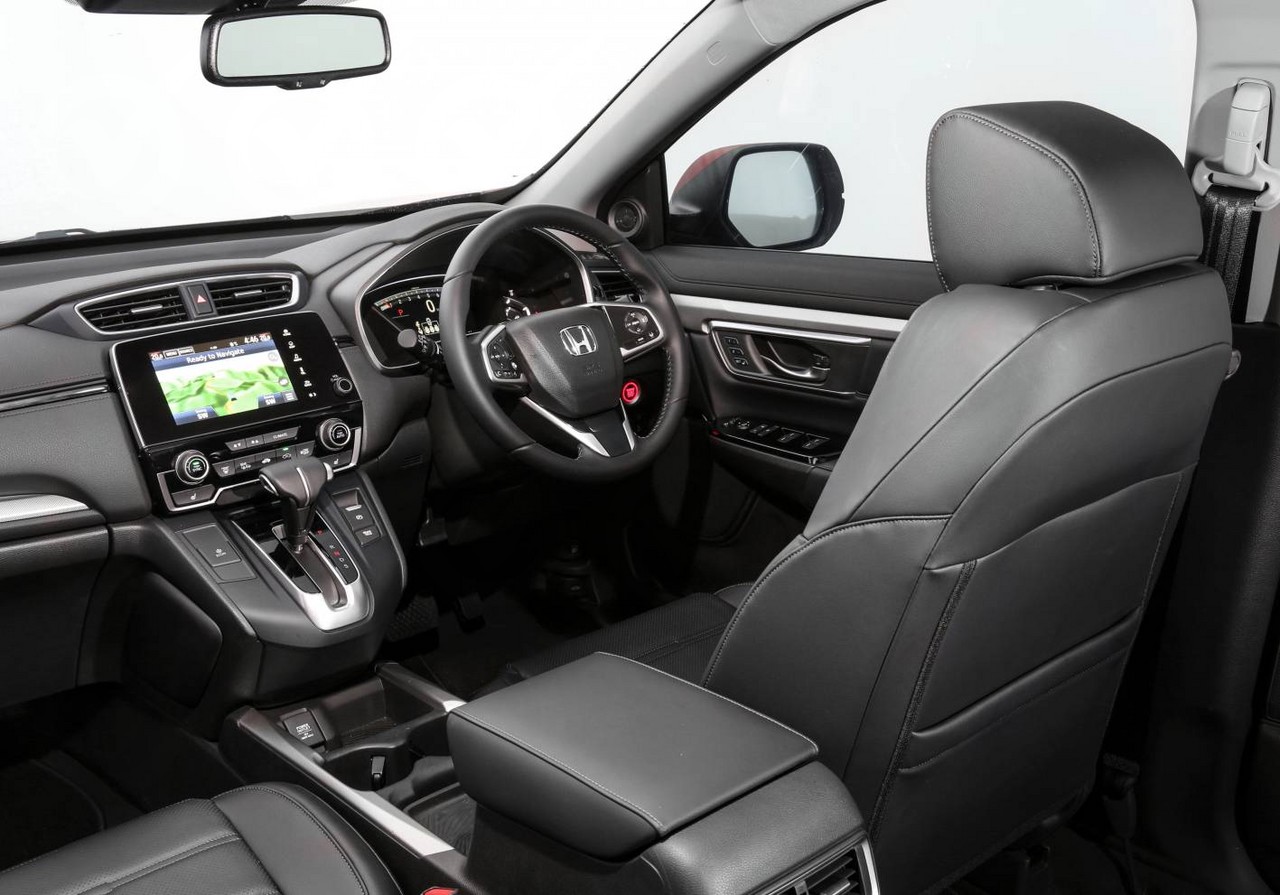
- Spacious interior
- Quiet, well-insulated interior
- High standard of interior fit and finish
- Ride is comfortable…
- … though dynamics are far from class-leading
- Undersized 1.5-litre L15B7 turbo petrol engine
- CVT causes ‘elastic band’ power delivery and makes droning noise
- Standard headlights are too dim
- Active safety technologies initially reserved for CR-V VTi-LX
- For CR-V VTi-L and above, sunroof reduces rear headroom
Overview
Released in Australia in July 2017, the Honda RW CR-V was a mid-size SUV that was available with five or seven seats. Manufactured in Ayutthaya, Thailand, the Honda RW CR-V was powered by a 1.5-litre L15B7 turbocharged petrol engine that was mated to a continuously variable transmission. For Australia, the Honda CR-V range consisted of front-wheel drive VTi, VTi-S and VTi-L variants, and all-wheel drive VTi-S and VTi-LX variants. While the CR-V VTi, VTi-S and VTi-LX had five seats, the VTi-L had seven seats (see table below).
In January 2019, the seven-seat Honda CR-V VTi-E7 was released in Australia.
Honda CR-V: L15B7 engine
The L15B7 had a die-cast aluminium block with 73.0 mm bores and an 89.4 mm stroke for a capacity of 1496 cc. Within the block, the L15B7 engine had cast-in iron cylinder liners and the cylinder walls were subjected to a ‘plateau honing’ process to remove ‘microscopic high points’. Within the crankcase, the forged-steel crankshaft had micro-polished journals to reduce friction and the high-strength steel connecting rods were heat-forged in one piece and then ‘crack separated’ to create a light and stronger rod with an optimally fitted bearing cap. The aluminium pistons had:
- An optimised skirt design to reduce reciprocating weight;
- A molybdenum coating for the outer skirts – applied in a dot pattern – to reduce friction;
- Cavity-shaped crowns for stable combustion;
- Ion-plated piston rings to reduce friction; and,
- For cooling, twin oil jets directed at the underside of each piston crown.
The L15B7 engine had a pressure-cast aluminium alloy cylinder head that contained chain-driven, hollow double overhead camshafts with Variable Timing Control (dual ‘VTC’) for both the intake and exhaust camshafts. Of the four valves per cylinder, the exhaust valves were filled with sodium for heat dissipation.
To eliminate the need for a separate exhaust manifold, exhaust ports were cast into the cylinder head of the L15B7 engine. The mono-scroll MHI TD03 turbocharger had a nine-blade turbine impeller, electronic waste gate and provided peak boost pressure of 18.5 psi. Finally, the L15B7 engine had direct injection via multi-hole injectors and a compression ratio of 10.3:1.
| Engine | Drive | Variant | Seats | Trans. | Peak power | Peak torque |
|---|---|---|---|---|---|---|
| 1.5-litre L15B7 turbo petrol I4 | FWD | VTi, VTi-S |
5 | CVT | 140 kW at 5600 rpm | 240 Nm at 2000-5000 rpm |
| VTi-E7, VTi-L |
7 | |||||
| AWD | VTi-S, VTi-LX |
5 | CVT |
Continuously variable transmission (CVT)
The Honda RW CR-V had a continuously variable transmission (CVT) which consisted of an engine-driven torque converter which drove two variable-width pulleys that were connected by a steel belt. The steel belt had angled inner faces so that it could circle the angled pulley faces at varying diameters depending on the pulley width which adjusted the effective ratio between the pulleys. Computer control of the CVT enabled the ratio between the pulleys to be altered to suit driving conditions and accelerator pedal position.
During full throttle acceleration, the ‘G-Design’ shift logic would use stepped gear ratios (rather than variable ratios) to provide a more ‘connected� feel as engine and vehicle speed increased. According to Honda, the stepped operation also provided incremental improvements to acceleration performance.
Real Time AWD system
The Honda RW CR-V was available with Honda’s ‘Real Time AWD system’ which utilises a transfer case, propeller shaft, the rear differential, an electronically-controlled hydraulic pump and a multi-plate clutch. The multi-plate clutch connected the propeller shaft to the rear differential and was operated by an electric motor which drove a hydraulic pump. The electric motor was controlled by Honda’s ‘Intelligent Control System’ which apportioned power according to driver behaviour and road conditions. However, Honda’s ‘Real Time AWD’ was a pro-active system that sought to pro-actively prevent wheel spin by sending power to the rear wheels before wheel slip occurred. According to Honda, up to 40 per cent of the engine’s torque could be directed to the rear wheels if required. When rear wheel torque was not required – such as steady cruising – the rear axle was effectively decoupled to reduce drag.
Body and dimensions
The Honda RW CR-V shared its platform with the tenth-generation Honda Civic (i.e. the FC1/FC6 Civic sedan and the FK4/FK5 Civic hatch ). Compared to the fourth-generation Honda CR-V , the Honda RW CR-V is 11 mm longer (at 4596 mm), 35 mm wider (1855 mm), 4 mm taller (1689 mm for AWD models) and had a 40 mm longer wheelbase. The five- and seven-seat Honda CR-V models had luggage capacities of 522 and 150 litres, respectively, with the rear seats in position.
For the Honda RW CR-V, 56.5 per cent of the body consisted of high strength steel (i.e. 340 MPa or above), including 13.8 per cent ultra-high-strength hot-stamped steel (rated at 1500 MPa). Upon its release, tare masses for the Honda RW CR-V ranged from 1582 kg to 1670 kg.
Suspension and steering
The Honda RW CR-V had MacPherson strut front suspension with a tubular stabiliser bar and multi-link rear suspension that was mounted on a rear sub-frame with a solid stabiliser bar. In a first for the Honda CR-V, the suspension utilised fluid-filled compliance bushings front and rear.
The Honda RW CR-V had dual-pinion Electric Power Steering (EPS) with a steering ratio that varied over a 20 per cent range for a final, full off-centre ratio of 12.3:1; the steering wheel required 2.3 turns from lock-to-lock.
Safety equipment
Standard safety equipment for the Honda RW CR-V included dual front airbags, front seat-mounted side airbags, full-length curtain airbags (i.e. for front and second row occupants in five seat vehicles and for all three rows in seven seat vehicles), ABS, electronic brake force distribution, brake assist, electronic stability control, traction control and front seatbelts with pre-tensioners and load limiters.
As standard, the Honda CR-V was equipped with a ‘Driver Attention Monitor’ which monitored the driver’s steering inputs for signs of fatigue. The system assessed the driver’s attention on a four level bar graph and, if the number of bars dropped to two, a message would recommend that the driver take a break. At one bar, a buzzer would sound and the steering wheel would vibrate.
The Honda CR-V VTi-S and VTi-L were further equipped with Honda’s ‘LaneWatch’ camera. For ‘LaneWatch’, a camera was positioned below the passenger-side door mirror to increase the view of the passenger-side mirror by up to 80 degrees, with the camera output visible on the multi-information display.
Beyond this, the range-topping Honda CR-V VTi-LX was equipped with the following active safety technologies –
- Adaptive Cruise Control (ACC) with Low-Speed Follow (LSF): using a millimetre wave radar and monocular camera, ACC allowed the driver to set a desired speed and following interval from a vehicle ahead. Furthermore, the Low-Speed Follow function enabled the Honda CR-V to brake until the vehicle was stationary and then accelerate as the road ahead cleared;
- Collision Mitigation Braking System (CMBS) with Forward Collision Warning (FCW): used a millimetre wave radar located behind the front grille and a monocular camera located between the rear view mirror and windscreen to monitor the road ahead. When there was a risk of a collision with another vehicle or a pedestrian, the Forward Collision Warning (FCW) system provided visual and audible alerts. If the driver did not respond, varied levels of autonomous braking could be initiated to reduce vehicle speed;
- Lane Departure Warning (LDW): operating at speeds from 72 km/h to 180 km/h, LDW used the monocular camera to monitor vehicle position within its lane. If the vehicle departed its lane without the turn signal having being activated, the driver would be alerted via a visual warning on the multi-information display and steering wheel vibrations;
- Road Departure Mitigation (RDM): active at speeds from 72 km/h to 180 km/h, RDM used the monocular camera to identify lane markings. RDM used steering force to help the CR-V stay in its lane and, if the vehicle was detected leaving a lane marked by solid lines, braking force would be applied on one side of the vehicle. When RDM was activated, the driver would be alerted by visual warnings and steering wheel vibrations; and,
- Lane Keeping Assist System (LKAS): operating at speeds from 72 km/h to 180 km/h, LKAS used the monocular camera to detect lane markings. If the vehicle was drifting within its lane, LKAS used the Electric Power Steering (EPS) system to provide corrective steering, thereby assisting the driver to maintaining their position within the lane.
From January 2019 deliveries, the all-wheel drive Honda CR-V VTi-S was also equipped with these technologies.
Brakes
The Honda RW CR-V had 315 mm by 28 mm ventilated disc brakes and 310 mm by 10 mm solid rear discs.
ANCAP testing
In ANCAP testing , the 2017 Honda CR-V received a five star safety rating with an overall score of 35.76 out of 37. In the frontal offset test, protection for the front occupants was generally rated as good, though protection of the driver’s lower left leg was rated as adequate (i.e. a slight risk of serious injury). In the side impact and pole tests, maximum points were awarded.
Features: Honda CR-V VTi and VTi-E7
As standard, the Honda CR-V was equipped with Honda’s ‘Advanced Display Audio’ system which includes a seven-inch touch screen, a 180 watt sound system with eight speakers, an AM/FM radio, Bluetooth mobile phone connectivity and audio streaming, a USB input and smartphone integration via Apple CarPlay and Android Auto. The Honda CR-V is also equipped with ‘Active Noise Control’ which uses microphones to detect low-frequency noises and then emits reverse phase sound waves through the sound system as a counter-measure.
Beyond this, standard features for the Honda CR-V VTi included 7.5J x 17-inch alloy wheels with 235/65 R17 104H tyres, dual-zone climate control air conditioning, cloth seat trim, cruise control with speed limiters, halogen projector beam headlights, front fog lights, LED daytime running lights, a rear-view camera, 60/40 split folding rear seats, remote central locking with proximity key, power mirrors, power windows, tilt and telescopic steering wheel adjustment, push-button start, an electric parking brake, roof rails, a cargo cover, tyre pressure monitoring, a trip computer and an immobiliser.
From 1 July 2017, the Honda CR-V was sold with a five year, unlimited kilometre warranty; if the vehicle was used for commercial purposes, however, the warranty was limited to five years or 140,000 kilometres, whichever came first.
Relative to the CR-V VTi, the seven-seat CR-V VTi-E7 was further equipped with 18-inch alloy wheels, an eight-way power adjustable driver’s seat, leather-appointed seats and a leather-wrapped steering wheel.
Features: Honda VTi-S
Compared to the Honda CR-V VTi, the CR-V VTi-S was further equipped with 7.0J x 18-inch alloy wheels with 235/60 R18 103H tyres, a satellite navigation system with SUNA live traffic updates, front and rear parking sensors, dusk-sensing headlights, a leather-wrapped steering wheel, power folding door mirrors and a power-operated tailgate.
Features: Honda VTi-L
Relative to the CR-V VTi-S, the CR-V VTi-L added leather-appointed seat trim, heated front seats, an eight-way power adjustable driver’s seat with memory settings, rain-sensing wipers and a panoramic sunroof. As the only seven seat model in the range, the CR-V VTi-L also had third-row ceiling vents.
Features: Honda VTi-LX
The range-topping Honda CR-V VTi-LX was distinguished by its digital radio tuner (DAB+), a four-way power adjustable front passenger seat, directional LED headlights, LED front fog lights, heated door mirrors, a leather-wrapped gearshift knob, a tilt function for the passenger door mirror on reverse, an auto-dimming interior rear-view mirror and rear privacy glass.
For the CR-V VTi-LX, the LED headlights utilised Honda’s ‘High-Beam Support System’ (HSS). Operating at speeds above 40 km/h, HSS could automatically switch from high beam to low beam headlights if traffic was detected, and revert to high beams once the traffic had been overtaken or passed.
2018 Honda CR-V +Sport
The limited edition Honda CR-V +Sport was released in July 2018. Based on the Honda CR-V VTi, the CR-V +Sport was further equipped with 18-inch alloy wheels, front and rear parking sensors, Honda’s ‘LaneWatch’ passenger side camera, rear privacy glass, a black sports grille and ‘+Sport’ badge.
Brochure
Related links
